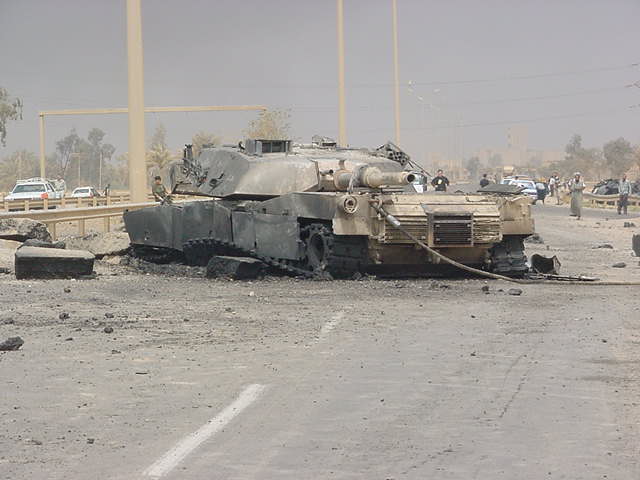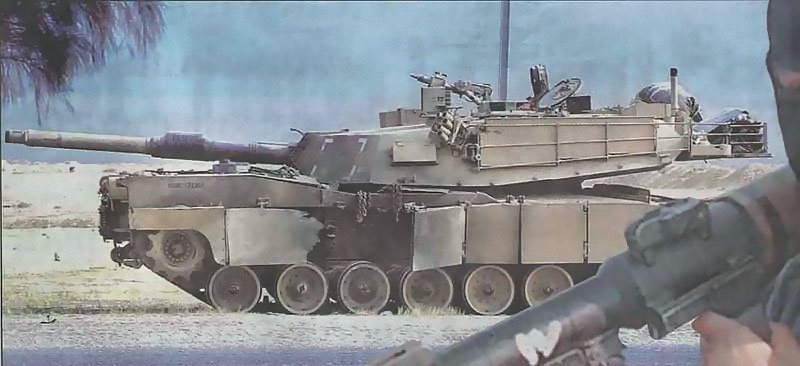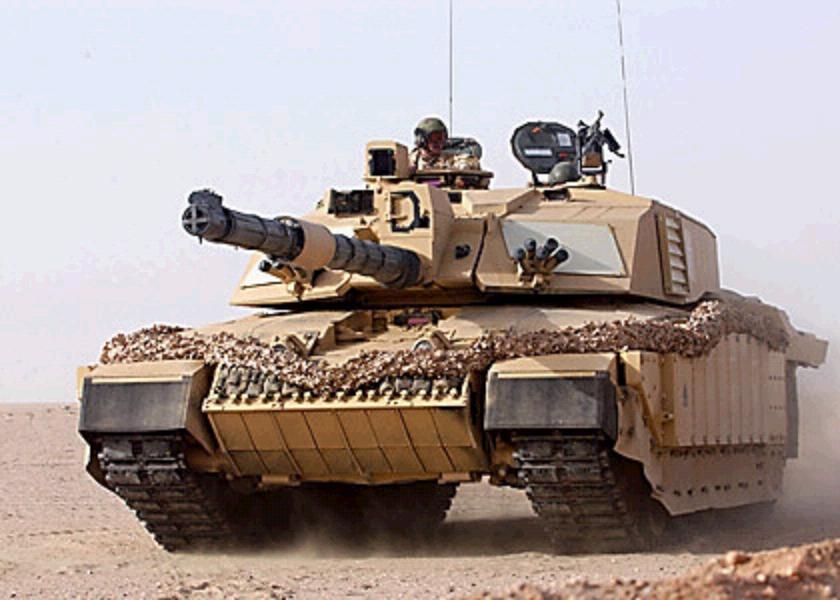-
Posts
1,020 -
Joined
-
Last visited
-
Days Won
1
Content Type
Profiles
Forums
Blogs
Gallery
Events
Store
Posts posted by Taz
-
-
Hi Rick,
Thanks for the promt reply.
Yes a tough one to put a price on. I'm awaiting more info on this particular group as we "speak". Most single Medals I have seen have been sold for ? 20-25 (28,50-35,50 USD), if docs are availiable and the medals are boxed I wonder what would be a "fair" price.
I am with you on the fact that I am not interested in investment or finanical gain. would be nice to have a rough idea of resonable prices though.
Best regards Eddie.
0 -
M1A2 "Cojone EH"

 0
0 -
And here two pics of damaged "Abrams" The first an M1A1.
The second probably being the most famous, seen all around the world the M1A2 "Cojone EH" from Bagdad bridge.

 0
0 -
Due to the extensive track damage I would say this is the Chally II damaged on April 6th, 2007 in Basra, when an IED shaped charge penetrated the underside of the tank.

 0
0 -
Hi guys,
I was wondering if anyone would like to try and make a rough price estimate on this Cuban group. All the Medals belonged to a Cuban Major who served in Angola and Mozambique.
The group consists of the following items:
1. Medalla "Combatiente Internacionalista" (II)
2. Conmemorativa, Marcos Marti ?
3. Distinci?n "Destacado en la Preparaci?n para la Defensa"
4. Distinci?n "Servicio Distinguido" (FAR)
5. Medalla "Por la Victoria Cuba R.P.A."
6.Cuban Cap, Cap Badge & star.
I'm not sure if they are boxed with award docs right now, I hope to have more details soon.
Does anyone have an idea?
Best regards Eddie.

 0
0 -
Friendly Fire Cockpit Video Iraq 2003
0 -
Johnsy,
Great photos, thanks!!
I'm curious, I would think the Aussies would have more of a connection to the Brits. Why not the Challenger??
Thanks.
Jim,
This Media release explains in detail why the "Abrams" was chosen as a replacement for the Leo.
http://www.minister.defence.gov.au/Hilltpl...?CurrentId=3643
Johnsy,
Excellent photo's
Regards Eddie
0 -
Challenger II and M-1 "Abrams"
Notice the Up-armoured Chally II and the turret mounted identification panels on both tanks which emit a thermal signature which can be seen at long distance using IR observation devices, developed to reduce Blue on Blue incidents.
Also the Chally uses the Bowman com system with a built in GPS processor. This updates all other network users of the vehicles battlefield position.



 0
0 -
So what would the ratio of Challengers to Abrams be in Iraq?
Total coalition tank strength was roughly 450 vehicles at the start of the operation. The 3d Infantry Division included over 200 M1A1s in its tank battalions and cavalry squadron. The 1st Marine Expeditionary Force had two tank battalions (virtually all the tanks in the active Marine Corps), with some tanks being provided to each of the three RCTs of 1st Marine Division. Additionally, one company of Marine Corps Reserve tanks was activated to support Task Force Tarawa. The British Army deployed two tank battalions in the 7th Armored Brigade with a total of 116 Challenger II tanks.
This would mean a ratio of about 1:3 at the start of Op Telic [the British designation for Iraqi Freedom]
Regards Eddie.
0 -
I think I`m right in thinking that the only thing that has taken out a Chally 2, is another Chally 2!!!!!!!
Blue on Blue, Operation IraqI Freedom
The first reported ground fratricide incident during Operation Iraqi Freedom (OIF) occurred shortly after midnight on March 24th, when a British Challenger II tank fired on another near Basra. This incident is of particular interest. The two tanks, Britain's most advanced MBT types, were part of a squadron of the Queen's Royal Lancers attached to the 1st Battalion Royal Regiment of Fusliers Battlegroup of the 7th Armoured Brigade. The tanks were engaging pockets of Iraqi soldiers near a bridge over the Qanat Shat Al Basra canal which runs along the western edge of the city. In a nearby sector, a troop of CR2 of 2 RTR was tracking a group of enemy personnel through their thermal sights, which had been reported by the battle group HQ. The 'target' was indicated as an enemy bunker position. The QRL Challenger was, unfortunately, in turret-down position, below the skyline, its crew working on the turret top, visible to the 2 RTR crew as the reported "enemy" troops.The RTR TC requested clearance to shoot, which was granted. Firing two shots of HESH at 4000 yards blew the turret off the QRL Challenger, killing two of the crew and seriously wounding the two others. Both tanks were fitted with visual identification systems in working order, but could not render clear visual contact, due to the hull-down positioned tank.According to reports, tanks in OIF were issued bolted-on identification panels, including those emitting thermal signature which can be seen at long distance using IR observation devices. However there seemed to remain also some of the older fluorescent sheets, used during Desert Storm on some of the AFVs.August 2006 - the driver of a Challenger II, Trooper Sean Chance, lost three of his toes when an RPG-29 penetrated the frontal armour during an engagement in al-Amarah, Iraq.
April 6, 2007 - in Basra, Iraq, an IED shaped charge penetrated the underside of the tank, resulting in the driver losing a leg and causing minor injuries to another soldier.
The outcome of one Chally II against another was inevitable.
The April 6th incident shows that if the charge is right, no tank is undefeatable as the underside is generaly weaker.
Of the three incidents the most worrying in my opinion is the RPG-29 "Vampir" penetrating the explosive reactive armour (ERA) .
However the The PG-29V tandem-charge Heat round used was designed for the sole purpose of defeating ERA armour, and this is the only time it has managed to do so on a Chally II.
Since then, and the following investigation as to why the ERA appears to have failed, no doubt measures have been made to combat the problem, although the outcome of the investigation remains an MoD secret because of security reasons.
Regards Eddie
0 -
Sadly after my Tankie days, it was only Chieftains, Scorpions and Scims for me

That is one "Beast" I would love to try.
Notice the 4th RTR eye on the turret in the clip.
http://www.youtube.com/watch?v=hcMVpY4SoO8
Regards Eddie.
0 -
Your welcome Richard,
I haven't seen any info on a WW II unit that went by that name yet, If I find anything I'll let you know. Scout is a rather unusual name for a WW II unit I would have thought they would have used Recce or reconnaissance unit more. Several irregular units were formed in the western desert though, Specialising in behind the lines raids and recon maybe it was one of those.
The LRDG used Bedford trucks for re-supply they were nicknamed Beddy's

Regards Eddie
0 -
Does anyone know anything about a British unit, that operated in North Africa during the Second World War, named Beddy's Scouts?
Any information would be appreciated.
Richard
Hi Richard,
The unit called Beddy's scouts that I know of was formed around 1900 in South africa and took part in the 2nd Anglo-Boer War. Is it possible that you mean this one?
Beddy's Scouts
This corps was raised for service in the extreme north of the Transvaal, the same wild district in which the Bush Veldt Carbineers had worked until disbanded. Beddy's Scouts made sundry small captures of prisoners during the period January to April 1902. At Spelonkin on 23rd March 1902 their post was attacked, but held out; Captain Beddy and several men were wounded. On 16th April they had fighting at Haenertsburg, and suffered some losses. Captain W. Beddy was mentioned in Lord Kitchener's final despatch, under the heading, "Intelligence Department".
Regards Eddie.
0 -
Does anyone have an image of this order prior to 1979?
Unfortunatly only a picture on a Cuban stamp but it gives the general idea of what the pre 1979 Order looks like.
Regards Eddie

 0
0 -
Here is a bit of info for you Nesredep
Marinepropagandaabteilung West (Paris)
Kommandeur
Kpt.z.S. Hinsch (Karl)08.40 - 04.43
KKpt. Giese (Fritz)04.43 - 10.43
KKpt. Dr. F?rer10.43 - 09.44
Marinepropagandaabteilung S?dost (Sofia)
Kommandeur
KKpt. Giese 02.41 - 04.43
KKpt. Stolzmann (Hans)04.43 - 07.44
Marinepropagandaabteilung Nord (Wilhelmshaven)
Kommandeur
KKpt. Hoefer (Karl-Heinz)03.40 - 06.43
0 -
Christian.
It's the State Prize of the Latvian SSR.
Regards Eddie.
0 -
Unlike many countries with stripes on the ribbon denoting the class of the Order or Medal the North Vietnamese system starts with the third class having one stripe, second two and the first class has three stripes, meaning that the award shown if the ribbon is correct, is the third class.
Best regards Eddie.
* Just a note to add- the same applies to the gold star devices third class one star, second class two stars and the first class has three stars on the ribbon.
0 -
Great - thanks for that Eddie. I think the last question I have is: which ships formed the German contribution to the international non-intervention force? The Deutschland (and I suppose the other larger surface vessels) did, since Germany withdrew after the Deutschland was bombed. The T-Flottille appears to have operated in supporte of these vessels so possibly did too. I'm pretty sure that the U-Boats didn't!
James,
In theory all of the ships were part of the non-intervention force, however after the bombing of the Deutschland on 29th May 1937 The "Admiral Scheer" together with the Torpedo Boats of the 2. T-Flottille (Seeadler, Albatros, Luchs und Leopard) shelled the harbour of Almeria on 31st May in a revenge attack. After this action, and the attacks by Republican submarine forces against the Leipzig off the port of Oran between 15th to 18th June 1937 Germany withdrew from the Non-Intervention Patrol.
U-boats participated in covert action against Republican shipping as part of Operation "Ursula". At least eight U-boats engaged a small number of targets in the area throughout the conflict.
In this operation was the sinking of the Republican submarine C-3 by The U-34 commanded by Kapit?nleutnant Harald Grosse.
Grosse was awarded the Spanienkreuz in Gold, the only Kriegsmarine man to receive it, and Kapit?nleutnant Kurt Freiwald (U-33) the Spainienkreuz in bronze. Because of the nature of the operations the awardings had to wait until the Spanish War was over, and they were not bestowed until June 1939.
Eddie.
0 -
James,
The "Saltzwedel" Flotilla under the Commander which formed it, Fregattenkapit?n Werner Scheer (September 1936 to July 1937) then later Korvkpt. Hans Ibbeken were active in the Spanish Civil War.
For the Blockade task the U-Boats were needed for they had to be ocean going boats not the smaller Type II coastal boats.
The class selected to perform this mission was the new type VII class (type VIIA), which were at the time only available in the 2nd Flotilla (Saltzwedel)
Ten U-Boats with the numbers U-27 through to U-36 were to be commissioned, however only five were operational by October 1936, U-27, U-28, U-30, U-33 & U-34
The U-33 and U-34 were chosen to take part in operation "Ursula" under the codenames Triton and Poseidon.
As far as I can tell the other U-Boats of the "Saltzwedel" flotilla were involved in various operations during the Spanish Civil War. Meaning that the following U-Boats were present:
U-27, U-28, U-29, U-30, U-31, U-32, U-33, U-34, U-35 & U-36
Regards Eddie.
0 -
-
Your welcome James,
Was the site in English or German, can you remember?
If anything else crops up while i'm browsing the net I'll let you know.
Regards Eddie.
0 -
Bit of info for you James,
The first military action of the Kriegsmarine came during the Spanish Civil War (1936?1939). Following the outbreak of hostilities in July 1936 several capital ships of the German fleet were sent to the region. The Deutschland, Admiral Scheer, and light cruiser K?ln were the first to be sent in July 1936.
These capital ships were accompanied by the 2nd Torpedo-boat Flotilla. Ostensively, the German presence was used to covertly support Franco's Nationalists although the immediate involvement of the Deutschland was humanitarian relief operations and the rescuing of 9,300 refugees from the fighting, including 4,550 Germans. Following the brokering of the International Non-Intervention Patrol to enforce an international arms embargo the Kriegsmarine was allotted the patrol area between Cabo de Gata (Almeria) and Oropesa. Numerous vessels served as part of these duties including Admiral Graf Spee. Uboats also participated in covert action against Republican shipping as part of Operation Ursula. At least eight uboats engaged a small number of targets in the area throughout the conflict.
On 29 May 1937 the Deutschland was attacked in the Deutschland incident off Ibiza by two bombers from the Republican Airforce. Total casualties from the Republican attack were 31 dead and 110 wounded, 71 seriously, mostly burn victims and in retaliation the Admiral Scheer shelled the harbour of Almeria on 31 May. Following further attacks by Republican submarine forces against the Leipzig off port of Oran between 15 ? 18 June 1937 Germany withdrew from the Non-Intervention Patrol although maintained a continuous presence in the area until the end of the conflict.
Torpedo-boats Luchs and Leopard.
http://www.deutschland-class.dk/deutschlan...ation_hist.html
Regards Eddie
0 -
Excellent photos!!

Did you notice that the para in post #5 is wearing the Pingat Jasa Malaysia (PJM) that we disscused in another thread on his award bar?
The officer in post #9 too.
regards Eddie.
0 -
Paul,
I think the emblem in the middle is that of the Kingdom of Saxony (K?nigreich Sachsen) maybe that will help a little to further identify the epaulettes. The pattern in the sheild is the Royal Standard 1815-1918.
Regards Eddie.



 0
0




Saw this........
in Armour, Vehicles, Ships & Aircraft
Posted
Johnsy,
Interesting point you made about the ASLAV'S hull design. That reminds me of Northern Ireland with The "Saracen". I've seen photo's of Saracens blown up by massive self-made cuvert bombs, all wheels and outer stored equipment gone but with the actual hull still intact.
The American contract seems to have fallen through from the information I found. Thales has teamed with US truck manufacturer Oshkosh to market the Bushmaster in the United States. In late June 2007 it was prematurely reported that the United States military was close to placing an order for 1500 vehicles as part of it's MRAP (Mine Resistant Ambush Protected) program. This sale did not go ahead, however and the Bushmaster was officially removed from the MRAP contest on 7th August 2007.
The Americans are to phase out its armoured Humvees in Iraq and Afghanistan and send in vehicles that better withstand roadside bomb blasts.
Replacing the Humvee, the military's main troop-transport vehicle, will be the Mine Resistant Ambush Protected Vehicle, known as an MRAP. Military officials say the new vehicles provide twice as much protection against improvised explosive devices (IEDs), which cause 70% of all U.S. casualties in Iraq.
The Up-armoured Humvees made it more likely to roll over, and its heavier doors trapped soldiers inside after an attack or accident.
Below the FPI Cougar (MRAP)